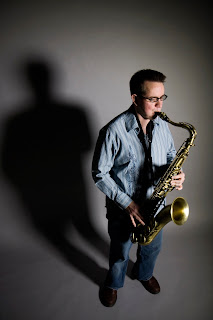Three weeks into his position as UIndy director of jazz studies, Mark O'Connor introduces himself as player-composer
 |
| Mark O'Connor just joined the UIndy faculty. |
It is an easy, strolling medium-tempo piece with a bit of a shrug in its step, and it provided a fine introduction to the university's new director of jazz studies, as well as something to make his new collaborators comfortable. They had no trouble finding a good comfort level: O'Connor himself seems to be an approachable colleague on and off the bandstand. Plus, they are among Indianapolis' best: pianist Steven Jones, bassist Nick Tucker, and drummer Kenny Phelps.
Griffin's number could be described as an Impressionist portrait of Monk, in contrast to Eric Dolphy's "Hat and Beard," an old favorite of mine, which is Cubist. But enough about painting! Back to the music.
O'Connor led the quartet through seven pieces, displaying his compositional chops as well. We heard the lovely ballad "Quiet Snow," with its gently arcing phrases and evocation of whiteness (talking Mother Nature here, not race!). The tenor saxophonist's solo showed his security in all registers. He put fairly large interval leaps in his solo without disturbing the lyrical line. His well-schooled tone had an abstract, slightly wistful quality in the high register, recalling the altoist Lee Konitz. Fluttery tremolo flourishes as O'Connor wound down his statement evoked drifty, swirling snowflakes.
Another natural phenomenon, the mirage, is dealt with more figuratively in O'Connor's piece of that title. The tempo is fast, the form intricate: "They nailed it," O'Connor said afterward of the rhythm section's performance of what he described as just about the hardest piece he's written. O'Connor showed off the heartiness of his horn's middle range, and his articulation was marvelous.
A couple of other O'Connor originals ended the recital. In "Suspended Reality" (the title work of one of two CDs for sale in the DeHaan Fine Arts Center lobby), Phelps' characteristic responsiveness came to the fore. He caught on to the leader's solo quickly and complemented its energy and rhythmic profile. The finale was "Blues for Ethan," a jumping number that brought out O'Connor's whimsical side. Solos from Tucker and Phelps were astonishing in cohesiveness without clutter as the performance approached its conclusion.
Bulking up the concert's middle were a couple of chestnuts: "East of the Sun" and "Chelsea Bridge." The former standard brought to O'Connor's mind his debt to Stan Getz, who recorded the song in a manner fondly recalled by the recitalist nearly 60 years ago with the Oscar Peterson Trio. After Jones' reflective rubato introduction, the quartet settled into a lope through the melody. Tucker's fine solo was a notable feature. If the influence of Getz was particularly evident, I sensed it especially in O'Connor's extension of the song's final cadence, which sounded like a conscious salute to the master.
I've rarely taken as many notes on a single piece at a jazz concert as I did for the quartet's rendition of Billy Stayhorn's "Chelsea Bridge." But I'm not going to dump them all here, you'll be glad to know. I just want to say how much I admired the variety of texture exhibited, the logical contrasts between the song's "A" section and its bridge, and Jones' effective balance of filigree and chords in his solo. Oh, and kudos for O'Connor's exceptionally creative soloing, bringing new perspectives to the tune, including a spellbinding long coda that was gracefully capped by his expert mates.



Comments
Post a Comment